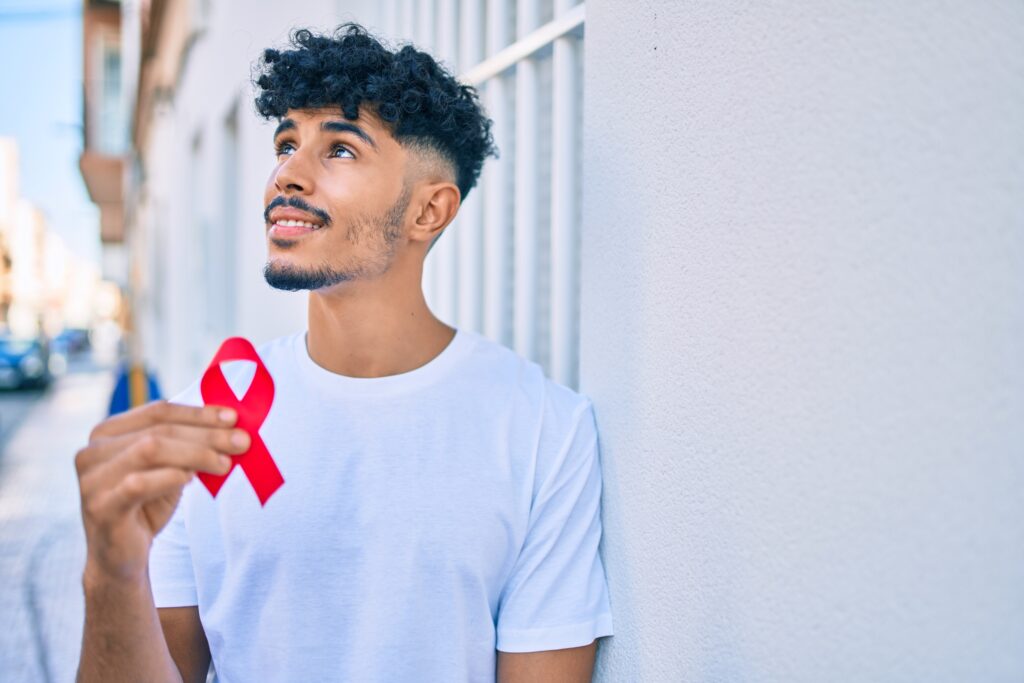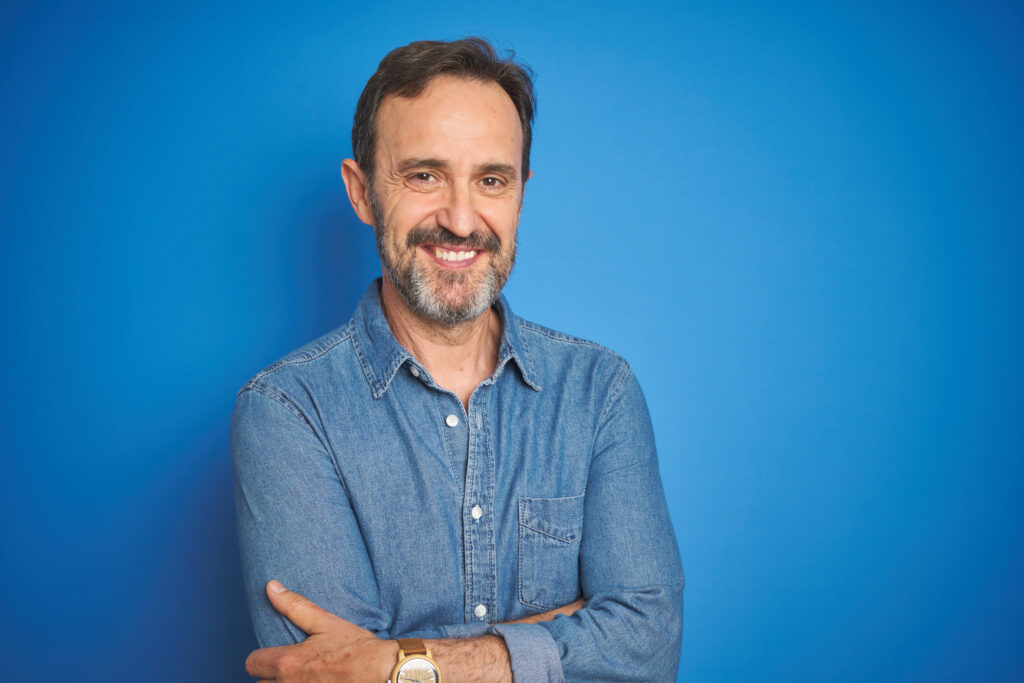
The history of the LGBTQ community is colored with both achievements and adversity. Oftentimes, the former is a result of the latter. The fight against HIV/AIDS, for example, is one of those instances. As we look back on LGBTQ history this month, it’s important to recognize the impact the HIV/AIDS epidemic has made on the community.
A Brief History of HIV/AIDS in the United States
In the United States, the first cases of AIDS weren’t reported until 1981. At the time, the LGBTQ community was making great strides in achieving civil rights and the sexual revolution had reached its peak.
Because HIV transmits much more easily through anal sex, men who have sex with men were, and continue to be, disproportionately affected by the virus. So, although they were far from the only ones who contracted the virus, gay AIDS victims were the ones who got the nation’s attention—and as a result, received the brunt of the backlash.
HIV/AIDS quickly became synonymous with the gay community, leading to terms like “gay plague” and perpetuating dangerous myths about the LGBTQ lifestyle. With fear and stigma rampant across the country, and a lack of government response to the virus, the LGBTQ civil rights movement was brought to a screeching halt. Instead, what resulted was increased discrimination, homophobic public health policies and an alarming number of diagnoses and deaths.
Taking matters into their own hands, activists in New York City founded the AIDS Coalition to Unleash Power, an organization credited with increasing education and awareness of HIV/AIDS (and speeding up the government’s response to the epidemic). Since then, we’ve made tremendous advancements toward eradicating the disease. Prevention, testing and treatment options have improved, general knowledge about HIV/AIDS has increased and the overall stigma has lessened.
Milestones throughout HIV/AIDS History
1981: The first cases of what would later be known as AIDS are reported in the United States.
1982: The Center for Disease Control (CDC) uses the term “AIDS" for the first time and releases the first case definition.
The Gay Men’s Health Crisis, the oldest HIV/AIDS service organization in the world, is founded in New York City.
1984: A retrovirus later known as HIV (Human Immunodeficiency Virus) is found to cause AIDS.
1985: The first commercial blood test for HIV becomes available.
1986: The International Committee on the Taxonomy of Viruses announces that the virus that causes AIDS will officially be known as “Human Immunodeficiency Virus” (HIV).
1987: The AIDS Coalition to Unleash Power (ACT UP) was founded in New York City.
1988: World AIDS Day is observed for the first time on December 1.
1989: The U.S. Congress creates the National Commission on AIDS and the number of reported AIDS cases in the United States reaches 100,000.
1991: The red ribbon becomes the symbol of AIDS awareness.
1992: In the United States, AIDS becomes the leading cause of death among men aged 25 to 44.
1994: AIDS becomes the leading cause of death for all Americans aged 25 to 44.
1995: The National Association of People with AIDS (NAPWA) launches the first National HIV Testing Day on June 27.
By October 31, 500,000 cases of AIDS are reported in the US.
President Clinton hosts the first White House Conference on HIV/AIDS on December 6.
1996: The number of new AIDS cases diagnosed in the U.S. declines for the first time since the beginning of the epidemic.
The U.S. Food and Drug Administration (FDA) approves:
- the first HIV home testing and collection kit (May 14)
- a viral load test, which measures the level of HIV in the blood (June 3)
- the first HIV urine test (August 6)
1997: The CDC reports that AIDS-related deaths in the U.S. declined by 47% compared to the previous year, the first substantial decline in AIDS deaths in the United States.
1998: The CDC issues the first national HIV treatment guidelines.
2008: “Undetectable equals untransmittable” is affirmed, proving that virally suppressed carriers can’t transmit the virus to HIV-negative individuals.
2012: The FDA approves first drug used for PrEP (pre-exposure prophylaxis) in uninfected adults.
Today, an estimated 13,000 people die of HIV/AIDS in the United States each year. But by spreading awareness, increasing access to testing, and making treatment more affordable, we can work to end the epidemic once and for all.

As modern medicine advances and treatments become more effective, the number of older adults successfully living with HIV/AIDS has grown. Still, misconceptions about the virus, how it’s spread and how it affects people only perpetuate stigma, causing many to delay testing and have late-stage infection at the time of diagnosis. By debunking these common myths, we can move one step closer toward eradicating HIV/AIDS once and for all.
Myths and Misconceptions About HIV/AIDS and Aging
Myth: Older adults aren’t at risk for HIV.
According to the CDC, over half of people living with HIV are aged 50 and older. And although new diagnoses among this group are declining, they still make up about 1 in 6, or 17%, of HIV diagnoses. Many risk factors that affect younger people, like having unprotected sex, having multiple sexual partners and sharing intravenous drugs, are just as common—if not more so—among older adults.
Myth: Older adults know more about HIV.
Despite being older, plenty of misinformation about HIV/AIDS still exists among people over 50. Older adults are also less likely to discuss sexual behaviors or drug use with their healthcare providers, resulting in a lack of knowledge about HIV prevention.
Myth: There is less stigma surrounding HIV in older adults.
Unfortunately, the HIV/AIDS stigma is heightened among older adults due to ageism and discrimination. Many who fear isolating themselves even further from their community or loved ones may feel more hesitant to seek treatment or disclose their status. And newly diagnosed adults can experience higher rates of self-blame for contracting the virus.
Myth: You can easily tell when someone, especially an older adult, has HIV.
Because HIV symptoms can be confused with normal signs of aging, it can be more difficult to diagnose it in older adults. Common symptoms may include:
- Muscle aches
- Rashes
- Fatigue
- Loss of appetite
- Diarrhea
- Weight loss
You may also remain asymptomatic for months after contracting the virus, making it almost impossible to detect HIV in its early stages. Getting tested is the best, most effective way to protect yourself and your loved ones.
Myth: You can’t live a long, healthy life with a positive diagnosis.
Compared to all people living with HIV, those over the age of 55 had higher viral suppression rates—meaning they had undetectable viral loads and could not transmit HIV to their partners. And while there’s no cure for HIV, taking effective treatment can result in a normal life expectancy, typically free from any complications or illnesses related to a positive HIV status.
Testing positive for HIV may come as quite a shock. And with that comes a wide range of emotions—as well as a lot of questions. But it’s important to remember that your diagnosis doesn’t define you or what the rest of your life will look like. Regular testing, early detection and effective treatment all play a role in making your life the best it can be.
This summer, Crew Health met with My News 13 on two occasions.
In June, our CEO, Chad Stowers spoke with My News 13 again about visiting the Pulse Night Club Memorial in honor of the five year remembrance of the Pulse Night Club shooting.
We also had the opportunity to discuss the Crew Health mission with the outlet and share our effort to make a positive impact on healthcare for the Greater Orlando community.

Now that Pride Month has come to an end, brands have swapped out their rainbow logos, street parades have dwindled down, and the colorful merchandise has come off the shelves. But pride is about more than rainbows and parades, and it shouldn’t be confined to a single month of the year. In fact, Pride Month should be used as a starting point for advocacy and exploration.
In addition to fun and fabulousness, pride also means fighting for equal rights, uplifting the community, and honoring those who paved the way. So, coming off the heels of Pride Month, it’s important to continue driving that momentum and keep making strides toward progress, inclusion and equality. Here are a few different ways you can join us in making every month a month of pride.
How to Show Pride After Pride Month
Celebrate LGBTQ+ victories. The modern-day LGBTQ+ rights movement began in 1969, when a police raid of a gay club—the Stonewall Inn—sparked six days of riots and protest. Since then, we’ve made great strides toward achieving equal rights, but the fight isn’t over yet. Whether you’re an ally or a member of the LGBTQ+ community, remember to champion the successes of LGBTQ+ individuals and honor those who’ve helped us get here.
Support and donate to LGBTQ+ organizations. There are many organizations like GLAAD, The Trevor Project, the Marsha P. Johnson Institute and the Center for Black Equity (as well as local nonprofits like us) that are working to make change happen in the world. Do your research to find one with a mission that resonates with you and learn how you can help support them. Some organizations might need monetary donations, while some could use gear, volunteers for their next event, or even just someone to help them spread awareness.
Amplify LGBTQ+ voices. To create social change, we need to center the voices of those who have personally experienced certain issues. Rather than speaking for them, make space for LGBTQ+ individuals to share their unique stories and listen to what they have to say. Then, help spread their message by sharing their original content, retweeting their posts, linking to their articles or videos, etc.
Learn, unlearn and relearn. Actively try to educate yourself about LGBTQ+ history and challenge any internalized biases you may have surrounding gender or sexuality. It’s OK to not know everything or to make mistakes—what matters is making a conscious effort to be better every day.
Normalize sharing your pronouns. By making it common practice to share pronouns, we challenge the idea that gender can be assumed simply by appearances. Include your pronouns in your social media bios and email signatures, as well as when you introduce yourself to someone. It’s a simple—but important—step toward creating a safe space for all gender identities and helping people feel pride in themselves.
Join the fight against HIV. Take pride in getting tested! Help eliminate the stigma surrounding HIV by knowing your status and protecting your health. Talk openly about HIV to combat misinformation and encourage others to know their status as well.
The LGBTQ+ community has made great strides since the days of Stonewall and it’s important to take pride in that—not just during Pride Month, but throughout the entire year. Using these ideas as a starting point, together we can make every month a month of pride.
It’s no secret—your teenage years can be tough. Between getting good grades, fitting in at school, entering the dating scene, balancing extracurriculars, and getting their first jobs, today’s youth are under a great deal of pressure. And when you’re on the LGBTQ spectrum, the pressure somehow becomes even greater. In addition to the “typical” challenges that adolescents face, LGBTQ youth experience unique stressors that can negatively impact their mental health.
According to a national survey by The Trevor Project:
- 68% of LGBTQ youth reported symptoms of generalized anxiety disorder, including more than 3 in 4 transgender and nonbinary youth
- 55% of LGBTQ youth reported symptoms of major depressive disorder, including more than 2 in 3 transgender and nonbinary youth
- 40% of LGBTQ youth seriously considered attempting suicide, including more than half of transgender and nonbinary youth
Bullying & Discrimination
The “high school bully” has become a popular trope in TV and movies, but bullying is an unfortunate reality for many LGBTQ adolescents—much more than for straight cisgender youth. CDC data shows that 43% of transgender youth and 29% of gay or lesbian youth have been bullied on school property (compared to 18% of cisgender youth and 17% of straight youth, respectively).
61% of transgender and nonbinary youth reported being prevented or discouraged from using a bathroom that corresponds with their gender identity, with school being the most frequent place where bathroom discrimination occurs. And 1 in 3 LGBTQ youth reported being physically threatened or harmed in their lifetime due to their sexual orientation and/or gender identity.
Dating Abuse
From first dates to first kisses, entering the dating scene as an adolescent can be both exciting and overwhelming. For LGBTQ youth, who may be exploring their sexuality or coming to terms with their identity, dating can feel a bit more daunting. LGBTQ teens face a higher risk of dating abuse, including physical/emotional abuse and sexual coercion. Transgender youth, in particular, are the most at-risk group.
Political issues
With the prevalence of social media, political talk seems to be more prominent than ever—and teens are listening. But while most teens don’t necessarily have to worry about things like healthcare and marriage equality, these issues directly affect the lives of LGBTQ individuals. In fact, 86% of LGBTQ youth said that recent politics have negatively impacted their well-being.
Puberty & Body Image
For many teens and preteens, puberty can feel like a time of chaos. But for transgender youth, it can lead to intense anxiety, depression and risk of suicide. During this time, your emotions, appearance and internal chemistry are all changing at a rapid pace, which can be very distressing—even traumatic—for someone whose gender identity doesn’t match their assigned sex. Markers of puberty, such as body hair, menstruation and developing breasts, can cause some to feel at odds with their bodies,
When seeking mental health treatment, it’s important to have a culturally sensitive provider who understands the LGBTQ experience. At Crew Health, we’re here for you in more ways than one. Not only do we offer LGBTQ-focused healthcare, but we do so at little to no cost to you—regardless of whether or not you’re insured. To us, your mental health is just as important as your physical health. Our team of experts is ready to talk to you no matter the need.
Sources:
2020 National Survey on LGBTQ Youth Mental Health, The Trevor Project
Youth Risk Behavior Surveillance, Centers for Disease Control and Prevention (CDC)

It’s our favorite time of year: Pride. A time to celebrate the culture, uplift the voices and support the rights of the LGBTQ community. And although National Pride Month is technically still a few weeks away, we’re kicking off the celebrations a bit early with our partners at Q Care+.
This Saturday, May 22, we’ll be dancing, cheering and waving our flags at the annual Tampa Pride Festival & Diversity Parade. But we can’t celebrate LGBTQ history without also commemorating the individuals we’ve lost to HIV and AIDS. That’s why it’s so important for us to have a presence at Pride events—to promote HIV testing and reach individuals who may be more at risk. By partnering with organizations like Q Care+, a telemedicine platform, we can increase access to treatment and help reduce the stigma surrounding HIV.
Stigma and accessibility are two of the biggest obstacles we face when it comes to ending the HIV epidemic. Feelings of shame, guilt and fear can cause some individuals to avoid getting tested, delay seeking treatment, or disclosing their status to their partners. Moreover, some people living with HIV may not have access to the resources needed to properly treat their condition—like health insurance or LGBTQ-focused providers. By offering at-home labs and STD testing, virtual doctor visits, mail-order prescriptions and refills, and 24-hour access to a secure online portal, Q Care+ creates an accessible, stigma-free space.
“It gives patients the option to access PrEP through partnerships that ensure quality of medication and provide ease of access to providers and treatment,” said Quinton Rasberry, CEO of Q Care+.
Pride events are known for being big, loud, unashamed and unapologetic. And that’s a message we want to emphasize to anyone living with HIV. Your status is nothing to be ashamed of or embarrassed about. You’re not alone in your diagnosis. Finding out you have HIV can be difficult, but with treatment and support, people with HIV can live long and fulfilling lives. So be proud of who you are—every part of you. We’ll see you at Pride!
ORLANDO, Fla. (April 8, 2021) – Crew Health, Inc., the Orlando-based primary care and infectious disease clinic that specializes in reducing sexually transmitted infections and serving the LGBTQ+ community, has kicked off 2021 on a high note with fresh goals and positive accomplishments already met after the first quarter and ambitious goals for the rest of the year.
Since January, the clinic has administered 350+ HIV tests in the community, 125 of which resulted in the patient starting PrEP medication. With sights set on an even bigger second quarter, Crew Health’s outreach team has a goal of completing 450 more tests and starting 200 more patients on PrEP before July 1, 2021, ensuring that the risk of exposure to HIV in the community is lower than ever.
A significant part of what will make the realization of this goal possible, is the launch of Crew Health’s mobile testing unit, slated to open by the end of May. The mobile unit will help the team reach new communities. In addition to the mobile unit, Crew Health is planning a larger mobile unit later this year that will allow for treatment and other services, including testing and behavioral health. These mobile units are made possible through generous donations from partners like Freedom Boat Club.
Crew Health is also excited to announce that its once ARNP, Amber Siegel, has become a doctor. Siegel received her Doctor of Nursing Practice at Duke University. In addition to Siegel, Crew Health’s team includes individuals such as Dr. Anjum Mobin, an in-house psychiatrist who specializes in psychological and emotional issues, and Dr. Sandra Lechin, a licensed psychologist with more than 10 years of experience with both inpatient and outpatient services, who both work within our Behavioral Health team.
Crew Health Inc. has also welcomed on-board other new members of staff since January, including new medical assistant Gessenia, administrative staff Suleika and LuAnn as well as Dorothy who looks after our accounts team. We also have Ivan who is our newest HIV/STI Counselor. In addition to our new members, there have also been some staff movements, including Margaret, who is now our office manager and Solitaire who in addition to heading our marketing department has also moved into our development team which now also includes Holly. More information about these members of the team can be found on our website.
“This is a very exciting time at Crew Health,” said John Tatum, chief operating officer. “As COVID-19 vaccinations become more available, it is becoming easier to get back into the communities that we serve and offer testing and essential care to our patients. We have extremely ambitious goals for this year, and through community events, partnerships, and expanding our high-quality patient care, we will continue to be a much-needed resource in Central Florida and beyond."
#
About Crew Health:
Crew Health, Inc. is a 501c-3 nonprofit healthcare organization dedicated to providing free, top-notch medical care and case management with a focus on the LGBTQ+ community. Based in Orlando, Florida, the organization’s in-house team is working toward its vision of ending HIV, disparity, and discrimination in the community. For information on Crew Health’s services, including free testing, visit CrewHealth.org or contact Hello@CrewHealth.org.
Welcome to the blog of Crew Health! We’re so glad you found us.
We wanted to create a safe space to help, educate and update our community on what we are up to regardless of where you are. Staying connected and supporting you in every way is important to us. We intend to cover a variety of topics to be a viable resource for you at every step.
What are we up to right now?
We have just undergone a complete rebrand! We are so excited to share what we have created with you all. We put a lot of thought and time into developing exactly what you needed from us, as well as extras that benefit your total wellness experience.
This new take on Crew Health is even more patient-focused than before. Crew Health is now a place of community and offers more resources like our blog to help you navigate care and life. Take a look around and keep an eye out for regular updates!
Got an idea for a topic? Let us know!